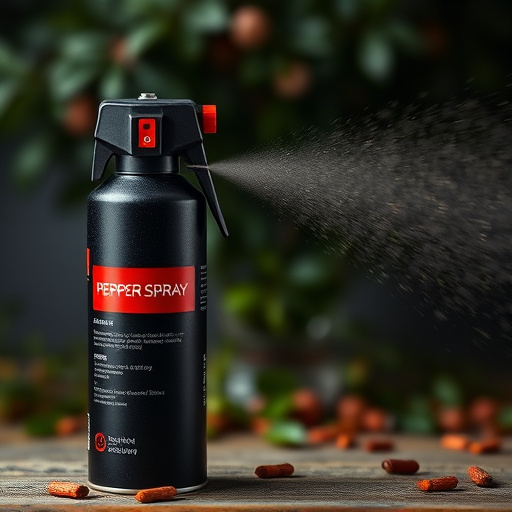Bear spray, a capsaicin-based defense tool, is crucial in first aid kits for areas with bear activity, aiding in deterring and managing wildlife encounters. Proper usage involves aiming at the bear's face, offering an escape window. Essential kit components include bandages, antiseptics, pain relievers, a whistle, and emergency contacts. Basic post-exposure care includes medical attention and washing pepper spray residue. Preventive measures emphasize understanding local wildlife behavior, carrying reliable bear spray, and using loud noises to deter threats.
“In areas where wildlife encounters are common, understanding how to defend against animal attacks is crucial. One powerful tool in your safety kit? Bear spray. This article delves into the world of bear spray defense, exploring its effectiveness and practical use. We’ll guide you through ‘First Aid Supplies for Pepper Spray’, offering essential items to prepare for an encounter. From understanding the mechanics of bear spray to post-exposure care, this comprehensive resource ensures you’re equipped with knowledge to navigate potential risks.”
- Understanding Bear Spray: What It Is and How It Works
- First Aid Supplies for Pepper Spray: Essential Items to Have on Hand
- Effective Use of Bear Spray During an Encounter
- Post-Exposure Care: Recovery and Prevention Tips
Understanding Bear Spray: What It Is and How It Works
Bear spray, also known as pepper spray designed for wildlife encounters, is a specialized defense tool used to deter and repel bears during potentially dangerous meetings. It’s more than just an irritant; it’s formulated to create a temporary yet potent disability, allowing individuals to escape or defuse the situation safely. Understanding how bear spray works is crucial when considering it as part of your first aid supplies for pepper spray in areas known for bear activity.
The active ingredient in bear spray varies but often includes capsaicin, the same compound that makes chili peppers spicy. When sprayed, these compounds irritate the eyes, nose, and respiratory system of the bear, causing it to recoil and temporarily disable itself. This window of opportunity allows users to retreat or, in some cases, fight back more effectively. Proper usage involves aiming for the bear’s face and eyes, as these areas are most sensitive to the spray’s effects.
First Aid Supplies for Pepper Spray: Essential Items to Have on Hand
When carrying bear spray as a defense mechanism against animal attacks, it’s paramount to be prepared for any eventuality. Alongside your pepper spray, assembling an effective first aid kit dedicated to bear spray injuries is crucial. This kit should include essential items like sterile bandages and gauze to manage bleeding, antiseptic wipes for cleaning wounds, and pain relievers to mitigate post-exposure discomfort.
Additionally, consider adding a whistle for signaling help in case of emergencies, as well as emergency contact information. Having these first aid supplies readily available ensures you’re equipped not just to deter an attack but also to provide immediate care should any adverse reactions occur following exposure to bear spray.
Effective Use of Bear Spray During an Encounter
During an encounter with a bear, proper use of bear spray can be a game-changer. It’s crucial to remember that timing and technique are key to its effectiveness. When faced with an aggressive bear, quickly pull out your spray and aim for the bear’s face and eyes—the primary targets for irritation and disorientation. A successful shot should create a cloud of pepper spray, temporarily blinding and distracting the bear, allowing you precious time to escape or climb a nearby tree.
Having basic first aid supplies for pepper spray on hand is essential. This includes items like eye wash and soothing wipes to help you manage the after-effects if the spray makes contact with your own eyes or skin. Additionally, ensure you’re familiar with local regulations regarding bear spray possession and usage to effectively navigate any potential encounters while outdoors in bear country.
Post-Exposure Care: Recovery and Prevention Tips
After an animal attack, it’s crucial to prioritize post-exposure care. If a bear spray defense was used, individuals should immediately seek medical attention for any injuries sustained during the encounter. Wash any affected areas with soap and water to minimize irritation from pepper spray residue. In terms of first aid supplies for pepper spray, having eye wash or irritant-neutralizing solutions on hand can aid in soothing eyes and skin.
Prevention is key when it comes to bear spray and future encounters. Individuals should familiarize themselves with local wildlife behavior and habitat areas. Carrying the appropriate First Aid Supplies for Pepper Spray, such as a reliable bear spray and personal protective equipment, can provide an extra layer of security. Additionally, making loud noises during potential threats may deter aggressive animals.
Bear spray is a valuable tool for defending against animal attacks, particularly in areas with high bear populations. Understanding its composition, usage, and post-exposure care is crucial for effective protection. When combined with the right first aid supplies for pepper spray, including essential items like eye wash and bandages, individuals can enhance their safety during outdoor activities. By learning the proper techniques for use, as outlined in this article, you’ll be better equipped to navigate encounters and ensure a higher level of security while exploring bear country. Remember, knowledge is your best defense.
